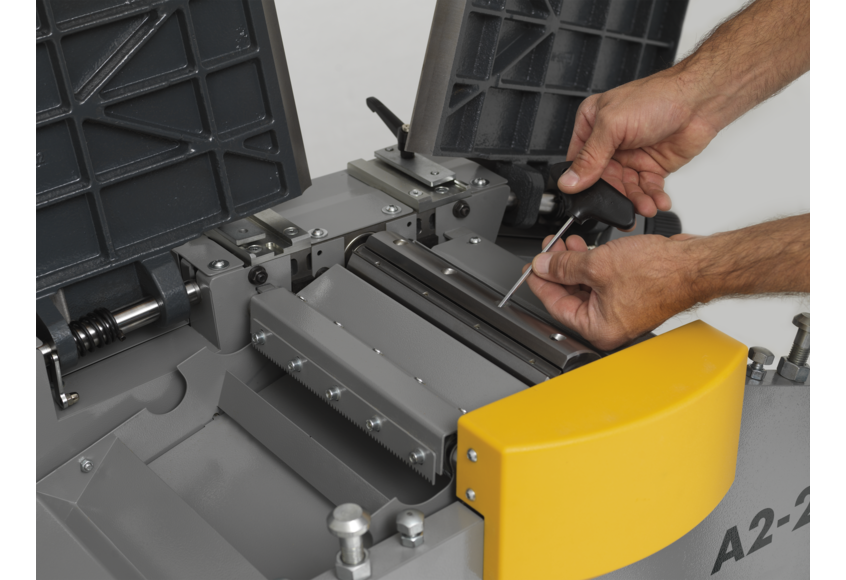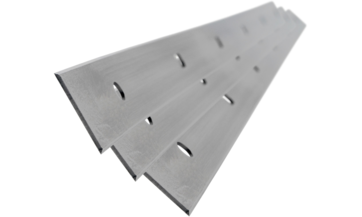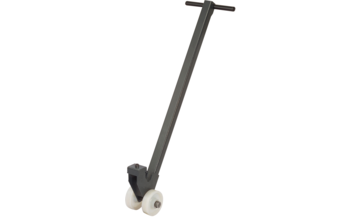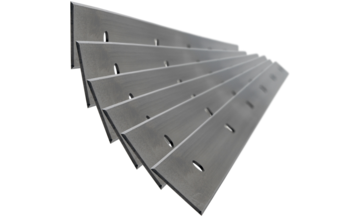Srovnávací a tloušťkovací frézka Hammer A2-26
- Srovnávací šířka: 260 mm
- Délka srovnávacích stolů 1045 mm
- Hoblovací hřídel: Automatické nastavení hoblovacích nožů
- Max. úběr třísky: 3 mm
- Tloušťkovací výška 3–184 mm
- Podávací rychlost 4,5 m/min
bez DPH , bez dopravného
vč. daně 21% , bez dopravného
Popis
A2-26 – NOVÁ "malá" srovnávací a tloušťkovací frézka zajišťující kvalitu a přesnost v malých dílnách
Nová A2-26 zaujme nejen svými příznivými rozměry pro malé dílny, ale také desetiletími prověřenými standardy srovnávacích a tloušťkovacích frézek Hammer.
Masivní srovnávací stoly z šedé litiny, jednoduchá obsluha a snadný přechod ze srovnávání na tloušťkování, ale především osvědčený hoblovacího hřídel Hammer se samonastavitelnými hoblovacími noži pro dokonale opracované dřevěné povrchy jsou působivé detaily, bez kterých se ve své dílně neobejdete.
Detaily
Třínožový hoblovací hřídel s automatickým nastavením je zárukou skvěle ohoblovaného povrchu dřeva a bezkonkurenčního komfortu obsluhy. Hoblovací hřídel s otočnými noži se od roku 1987 nesčetněkrát osvědčil a ušetřil našim zákazníkům na celém světě finančně náročné investice do běžných hoblovacích hřídelů s plnými noži. Hoblovací hřídele s otočnými noži jsou zabudovány pouze v hoblovkách firmy Felder!

Protahovací a srovnávací stoly se silnými žebry jsou zhotoveny z kvalitní šedé litiny a jsou v každé situaci naprosto přesné. Šířka srovnávacích stolů vždy odpovídá hoblovací šířce, a obrobky tak jsou při srovnávání bezpečně vedeny po celé délce srovnávacího stolu.

Úběr třísky se nastavuje pomocí otočného madla na zadní straně stroje! To uživateli zaručuje rychlé a přesné nastavení úběru třísky s maximální jednoduchostí použití. Maximální úběr třísky je 3 mm.

Srovnávací pravítko lze velmi snadno polohovat v rozsahu 90°–45° po uvolnění 2 ovládacích matek. Uživatel navíc odečítá úhel nastavení na dostatečně dimenzované stuplnici. 2 koncové dorazy v 90° a 45° zajišťují přesnost, úsporu času a snadné použití.

Prostorově úsporné a ergonomicky optimální řešení srovnávacích a tloušťkovacích frézek Hammer: srovnávací stoly se odklápějí ke středu stroje a tím nejen šetří místo v dílně, ale také zajišťují ergonomicky správný postup při protahování.

Technicky optimalizovaná odsávací hubice zabezpečuje ideální odsávání třísek a čisté pracovní stoly.

Maximální tloušťkovací výška činí 184 mm. Průchozí výška se odečítá na zřetelné stupnici na stojanu stroje. Nastavení tloušťky s přesností na desetinu milimetru lze na přání zajistit pomocí systémového ručního kolečka s integrovaným digitálním ukazatelem.

Technické údaje
| Délka srovnávacích stolů [mm] | 1045 |
| Frekvence [Hz] | 50 |
| Max. úběr třísky [mm] | 3 |
| Napětí [V] | 1x 230 |
| Výkon [PS] | 2,6 |
| Výkon [kW] | 1,9 |
Doporučené příslušenství
Systémové hoblovací nože HS-M42
500-07-011 | pro Felder / Hammer | Délka 260 mm
Hoblovací nůž pro systémový hoblovací hřídel FELDER, HAMMER a Format 4
pokračovatbez DPH , bez dopravného
vč. daně 21% , bez dopravného
Systémové ruční kolečko z hliníku
12.1.311 | Ø 160 mm
Vysoce kvalitní systémové ruční kolečko pro nastavení úhlu na strojích Felder a Hammer
pokračovatbez DPH , bez dopravného
vč. daně 21% , bez dopravného
Ukazatel polohy s digitálním zobrazením
01.1.202 | pro indikaci výšky tloušťkování a výšky vrtání Felder FD 250 | Zobrazení v mm
Vysoce přesný digitální ukazatel pro montáž do systémového ručního kolečka
pokračovatbez DPH , bez dopravného
vč. daně 21% , bez dopravného
Pojezdové zařízení pro Hammer Série 3 | bez zvedací oje
503-134 | pro Hammer A2 26, A3 26, A3 31, A3 41 (od roku výroby 09/2011), B3 basic, B3 winner, B3 perform, K3 basic , K3 winner, K3 perform, F3
Pojezdové zařízení pro pohodlnou přepravu strojů Hammer
pokračovatbez DPH , bez dopravného
vč. daně 21% , bez dopravného
Zvedací oj pro stroje Hammer
500-149
Zvedací oj pro rychlé a jednoduché přestavení strojů Hammer
pokračovatbez DPH , bez dopravného
vč. daně 21% , bez dopravného
Systémové hoblovací nože SS
500-07-010 | pro Felder Hammer | Délka 260 mm
Hoblovací nůž pro systémový hoblovací hřídel FELDER, HAMMER a Format 4
pokračovatbez DPH , bez dopravného
vč. daně 21% , bez dopravného
Tohle by Vás mohlo také zajímat
Zvedací oj pro stroje Hammer
500-149
Zvedací oj pro rychlé a jednoduché přestavení strojů Hammer
pokračovatbez DPH , bez dopravného
vč. daně 21% , bez dopravného
FAQs
Planers are used to produce flat and smooth wood surfaces. There is a distinction between surface planers and thickness planers or the combination of these two machines, the so-called planer-thicknesser. Before a "rough" board of solid wood or plastic can be cut to the desired thickness, the surface planer is used to produce a flat and smooth surface on one side and a flat and smooth surface at a 90-degree angle to it on the narrow side. Subsequently, the facing, unprocessed surface can be planed to the desired thickness with the thicknesser. The result is an entirely smooth and, above all, dimensionally and angularly accurate workpiece - a guarantee for the success of all subsequent machining or application processes.
The frictional resistance between the machine table and the wood is reduced with special lubricants developed for woodworking. Especially when working with resin-rich solid woods, the use of lubricants in woodworking is inevitable. Liquid lubricants are best suited and their application onto the machine table via a spray bottle is very simple and easy. When using lubricants, it is important to ensure that they are fully volatilised after processing to prevent any negative effects on subsequent surface treatments with stains and lacquers. Zde you can find Supergleit - the best choice for planing, but also as a lubricant for circular saw and moulding operations.
The purchase price of a planer depends on several factors - the type of machine, planing width, scope of performance and functions, the degree of automation or other desired features. Well thought out from the start, a perhaps higher purchase price pays off in the long run compared to a purely price-based purchase. Additional costs for high technology and work safety, which are incorporated as key components in planers, maintain their value over the years and even decades. One example: the Silent-Power® spiral cutterblock from Felder with spiral blade technology is many times quieter than other cutterblocks, protecting your ears and increasing work safety. The Silent-Power® spiral cutterblock also uses carbide reversible blades with 4-fold cutting edges - which increases the tool life by up to 20 times compared to HSS or SS cutting materials. The Silent-Power® spiral cutterblock therefore scores across the board and saves you money at the same time. Scroll up for a wide selection of planer/thicknessers in every price and performance range.
In many European countries, regulations require the sole use of clean-air extraction units in commercial establishments. Clean-air dust extractors reduce the dust load in the ambient air to 0.1 mg/m3 residual dust content. Of course, from the point of view of work safety and health, clean-air dust extractors are always a good choice - even beyond legal regulations. When choosing an air filter dust extractor, the dust load of the air in the workshop can also be reduced with so-called cartridge filters. The following applies to both clean-air and air filter dust extractors: The air speed at the machine-side extraction connection must be between 18 m/s and 22 m/s; 28 m/s for the continuous processing of predominantly wet wood. Extraction capacity calculations, which calculate both the cross-section of the necessary pipes or hoses and the required power of the extraction unit or system on the basis of the number of machines and the distance to be extracted, provide one hundred percent certainty for perfect extraction results. Of course, when extracting dust from a planer, the width of the cutterblock and the maximum possible chip removal must also be taken into account. These two values determine the expected volume of chips removed through the dust extraction hose or pipe system via the dust extractor system or unit. If the chip bags or containers are too small, the cycles for emptying them will increase considerably. Zde you can discover our large selection of dust extractors and filters.
Stationary planer-thicknessers are used for flush planing and levelling of solid wood. As a first step, the wood is planed. The workpiece is fed to the rotating cutterhead through the infeed surface planer table. The alignment of the infeed planer table is parallel to that of the cutting circle of the cutterblock. This distance between the planer table and the cutting circle is responsible for the chip removal and is usually adjustable; depending on the design, the chip removal can vary by up to several millimetres. After feeding the workpiece to the cutterblock and after chip removal, the workpiece passes over the outfeed planer table. The outfeed planer table and the cutting circle of the cutterblock are in parallel alignment, i.e. the cutterblock and the outfeed planer table are at the same level. The result is an aligned, flat and smooth wood surface. This process is called "planing", the corresponding machine is called "surface planer". The side opposite to the planed wood surface can now be planed to the desired thickness in a second work step. This operation is called "thicknessing" and the machine required for this is the "thicknesser". Thicknessers have a thicknessing table that can be adjusted to size in height. A feed roller, usually grooved or toothed, located in front of the cutterblock ensures that the workpiece is fed safely to the cutterblock. The cutting circle of the cutterblock corresponds to the set thicknessing table position, the chip removal rate possible in each case can be up to several millimetres. Behind the cutterblock is a smooth outfeed roller that gently transports the thickness-planed workpiece away from the cutterblock. Depending on the application, surface planers are used as stand-alone machines or as combined surface and thickness planers. Zde you can see the chip flight during planing work in super slow motion.
Generally, the main criteria for buying a planer is the intended area of use, a defined amount of space, ease of use and sustainability in terms of the cost of planer knives. A quick commercial answer is the intended area of use, planing, thicknessing or both in one, with a defined amount of use per day, per month or per year. The higher the expected workload, the higher the quality and stability required of a new planer/thicknesser. In terms of space, the mere machine footprint should not be considered the sole criterion; some planers require additional, valuable floor space due to their design - e.g. for protruding fences behind the machine. In any case, a very good alternative where space is limited are planer-thicknessers. Ease of operation comprises decision criteria such as set-up and changeover times, the latter especially in the case of planer-thicknessers. While the adjustment of planing or thicknessing tables is mainly done manually on smaller planers, electrical adjustment options with LED displays up to programmable positioning and roughing finishing allowances are mostly standard on larger planer-thicknessers. For decades, various manufacturers have been producing flawless, sustainable sets of planing knives using reversible knife technologies. Nevertheless, there are groundbreaking developments that are becoming more and more popular on the market, such as the Silent-Power® sprial cutterblock from Felder that reduces noise by half, equipped with carbide reversible cutting edges and 4 cutting chamfers per cutting edge. The tool life of carbide is 20 times higher than that of HSS or SS cutting materials. The Silent-Power spiral cutterblock therefore scores across the board and saves you money at the same time. You can find a wide selection of high-quality planer/thicknessers for many applications further up on this page.

























